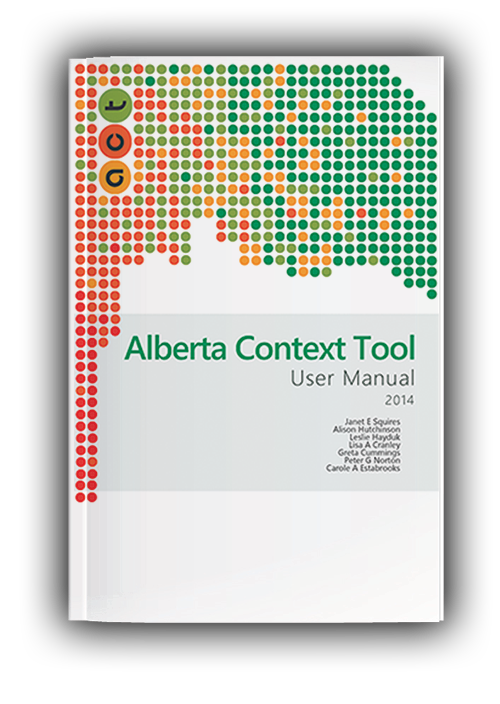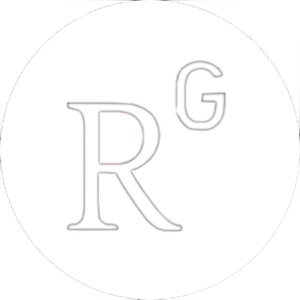Alberta Context Tool (ACT)
Alberta Context Tool
Measure organizational context in complex healthcare sett

What is the Alberta Context Tool?
The Alberta Context Tool is a survey used to measure organizational context
The Alberta Context Tool© (ACT) is a survey tool used to measure organizational context for use in complex healthcare settings (e.g., hospitals, nursing homes, community settings). It assesses individual healthcare provider's perceptions of organizational context. These perceptions can be aggregated to provide unit and higher level (e.g., hospital, facility) estimates of context. The ACT was developed to enable researchers to determine which elements of context facilitate and/or hinder successful knowledge translation (i.e., uptake of research knowledge by healthcare providers) and patient outcomes.
Versions
There are three different versions of the ACT, a version for each setting. Each setting has multiple forms, one form for each provider group. The ACT is available in five languages.

Settings
Acute Care (adult and pediatric)
Residential Long Term Care (nursing homes)
Community/Home Care

Provider Groups
Healthcare Aides
Professional Nurses
Allied Health Providers
Practice Specialists
Care Managers

Languages
English
French
Swedish
German
Dutch
Versions and languages available
Acute Care
| Professional Nurses | Allied Health | Practice Specialists | Care Managers | |
|---|---|---|---|---|
| English | ✅ | ✅ | ✅ | ✅ |
| French | ✅ | ✅ | ✅ | ✅ |
| Swedish | ✅ | | | |
| Dutch | ✅ | | | |
| German | | | |
Residential Long Term Care
| Professional Nurses | Allied Health | Practice Specialists | Care Managers | |
|---|---|---|---|---|
| English | ✅ | ✅ | ✅ | ✅ |
| French | ||||
| Swedish | ✅ | ✅ | ||
| Dutch | ✅ | | | |
| German | ✅ | ✅ | ✅ | ✅ |
Community/Home Care
| Professional Nurses | Allied Health | Practice Specialists | Care Managers | |
|---|---|---|---|---|
| English | ✅ | ✅ | ||
| French | ||||
| Swedish | | | ||
| Dutch | | | ||
| German | | |
Concepts
All forms of the ACT contain of a series of questions that tap eight unique dimensions of organizational context. The eighth dimension, organizational slack, is subdivided into three parts. Together, these dimensions and sub-dimensions comprise ten modifiable concepts. The number of questions included in each ACT form is 56 to 58 (depending on the form).
Leadership
Leadership
Leadership refers to the actions of formal leaders on a unit that influence change and promote excellence in practice and resident care. Formal leaders will vary according to the care provider completing the ACT; for example, with care aides, a variety of: care managers, RNs, and/or LPNs can be selected as ‘formal leaders’. Individuals completing the ACT are asked to rate this leader by answering six items using a 5-point Likert agreement scale ranging from 1 (strongly disagree) to 5 (strongly agree). The final leadership score obtained for each individual is an average of his or her scores on the six items. Higher scores reflect a more positive perception of the leadership on the care unit.
| Definition | # if items | Hypothesis | Sample item | Scale |
|---|---|---|---|---|
| The actions of formal leaders in an organization (unit) to influence change and excellence in practice; items generally reflect emotionally intelligent leadership | 6 | Care providers who perceive more positive (emotionally intelligent) unit leadership report higher research use | Looks for feedback to ideas and initiatives even when it is difficult to hear | 5 point Likert |
Culture
Culture
Culture refers to the way that “we do things” on care units. Individuals completing the ACT are asked to rate their unit’s culture by answering six items using a 5-point Likert agreement scale. The items generally describe a supportive work culture. The final culture score obtained for each individual is an average of his or her scores on the six items. Higher scores reflect a more positive perception of the culture on the care unit.
| Definition | # of items | Hypotiesis | Sample item | Scale |
|---|---|---|---|---|
| The way that “we do things” in our organization and work units; items generally reflect a supportive work culture | 6 | Care providers who perceive a more positive unit culture report higher research use | My organization effectively balances best practice and productivity | 5 point Likert |
Evaluation
Evaluation
Evaluation refers to the process of using data to assess team performance and to achieve positive (resident) outcomes on care units. Individuals completing the ACT are asked to rate the evaluation on their care unit by answering six items using a 5-point Likert agreement scale. The six items are hierarchical in nature and represent a process. The final evaluation score obtained for each individual is an average of his or her scores on the six items. Higher scores reflect a more positive perception of the feedback process mechanisms on the care unit.
| Definition | # of Items | Hypothesis | Sample Item | Scale |
|---|---|---|---|---|
| The process of using data to assess group/team performances and to achieve outcomes in organizations or units (i.e. evaluation) | 6 | Care providers who perceive a larger number of unit feedback mechanisms report higher research use | Our team routinely monitors our performance with respect to the action plans | 5 point Likert |
Social Capital
Social Capital
Social Capital refers to active connections and interactions among individuals on a care team. These connections are of three types: bonding (horizontal connections between individual team members on a care unit), bridging (connections between individuals on different care teams), and linking (vertical connections between individual team members and individuals in positions of authority, e.g., care managers). Individuals completing the ACT are asked to rate the connections on their care unit by answering six items using a 5-point Likert agreement scale. The final social capital score obtained for each individual is an average of his or her scores on the six items. Higher scores reflect a more positive perception of social capital on the care unit.
| Definition | # of Items | Hypothesis | Sample Item | Scale |
|---|---|---|---|---|
| The stock of active connections among people. These connections are of three types: bonding, bridging, and linking | 6 | Care providers who perceive more positive unit social capital activities report higher research use | People in the group share information with others in the group | 5 point Likert |
Informal Interactions
Informal Interactions
Informal Interactions refer to the informal exchanges that occur between individuals working on a care unit. Individuals completing the ACT are asked to indicate how often they interact in a variety of informal exchanges with individuals on their care unit by answering nine items using the same 5-point frequency scale. The final informal interactions score obtained for each individual is the number of individuals with whom he or she reported interacting. Higher scores reflect a higher number of informal interactions on the care unit.
| Definition | # of Items | Hypothesis | Sample Item | Scale |
|---|---|---|---|---|
| Information exchanges that occur between individuals working within an organization (unit) that can promote the transfer of knowledge | 7-10 | Care providers who perceive a larger number of informal unit interactions report higher research use | How often do you interact with people in the following roles or positions? - Someone who champions research and its use in practice | 5 point Likert |
Formal Interactions
Formal Interactions
Formal Interactions refer to formal exchanges that occur between individuals working on a care unit through scheduled activities. Individuals completing the ACT are asked to indicate how often they interact in a variety of formal exchanges on their care unit by answering four items using a 5-point frequency scale: 1 (never), 2 (rarely), 3 (occasionally), 4 (frequently), 5 (almost always). The final formal interactions score obtained for each individual is a count of the number of items in which he or she indicated they participated. Higher scores reflect higher numbers of formal interactions engaged in on the care unit.
| Definition | # of Items | Hypothesis | Sample Item | Scale |
|---|---|---|---|---|
| Formal exchanges that occur between individuals working within an organization (unit) through scheduled activities that can promote the transfer of knowledge | 4 | Care providers who perceive a larger number of formal unit interactions report higher research use | How often do these activities occur? - Team meetings | 5 point Likert |
Resources
Structural / Electronic Resources
Structural and Electronic Resources refer to the structural and electronic elements of a care unit that facilitate the ability of individual team members to use best practice (or research) knowledge. Individuals completing the ACT are asked to indicate how often they use a variety of structural and electronic resources on their care unit by answering eleven items (7 items on structural resources and 4 items on electronic resources) using the 5-point frequency scale. Final structural resources and electronic resources scores are obtained for each individual by obtaining a count of the number of resources he or she indicated using. Higher scores reflect the use of more structural and electronic resources on the care unit.
| Definition | # of Items | Hypothesis | Sample Item | Scale |
|---|---|---|---|---|
| The structural and electronic elements of an organization (unit) that facilitate the ability to assess and use knowledge | 11 | Care providers who perceive a larger number of unit structural and electronic resources report higher research use | How often do you use/attend the following? - Notice boards | 5 point Likert |
Organizational Slack
Organizational Slack
Organizational Slack refers to the cushion of resources, which allow a care unit to adapt successfully to internal pressures or changes or adapt to external pressures or changes. Organization slack has three components (or concepts):
- Staffing (availability of adequate staffing levels to provide resident care; 3 items);
- Space (availability and use of adequate space to provide resident care and share best practice knowledge; 3 items);
- Time (availability of time to provide resident care and share best practice knowledge; 4 items).
A variety of scoring methods are used to obtain final scores for each of the three organizational slack components. Higher scores reflect a more positive perception of staffing levels, the availability and use of adequate space, and the availability and use of time on the care unit to carry out resident care and share knowledge.
| Definition | # of Items | Hypothesis | Sample Item | Scale |
|---|---|---|---|---|
| The cushion of actual or potential resources which allows an organization (unit) to adapt successfully to internal pressures for adjustments or to external pressures for changes. | | | | |
| Staff | 2-3 | Care providers who perceive sufficient unit staffing levels report higher research use | Enough staff to deliver quality care | 5 point Likert |
| Space | 3 | Care providers who perceive having sufficient time on their unit report higher research use | Use of designated space | 5 point Likert |
| Time | 4 | Care providers who perceive having sufficient space on their unit report higher research use | Time to do something extra for patients | 5 point Likert |
Request Access
The Alberta Context Tool is free to use for anyone who deems it appropriate for their research. However, using it in research requires the permission of the copyright holder, Dr Carole A. Estabrooks. You can request access to the Alberta Context Tool depending your needs and where you are in your research process.

Preview Access
Step 1: Request Preview Access to view the ACT to see if it is appropriate for your research, or to submit it with a grant or an ethics application.
Email: kusp@ualberta.ca
Conditions of Use
Alberta Context Tool (ACT) Conditions of Use
The Knowledge Utilization Studies Program (KUSP) will provide the researcher with a copy of the Alberta Context Tool (ACT). The researcher is responsible for the reproduction of ACT, the distribution of the survey, and the collection of data.
The researcher will retain full rights to the data for publication. On completion of the study the researcher will forward a digital copy of the ACT and demographic data from their study. These data will be used to assess the psychometric properties of the ACT and to build the ACT’s normative record on an ongoing basis. KUSP will retain rights to use these data within analyses of its larger ACT data set but will not publish analyses based on these data alone.
The data should be received within one year of project completion and submitted as follows:
- in Excel format
- with documentation (i.e., codebook)
- uploaded to the HRDR secure sharepoint site (by arrangement with the TREC Data Manager)
The researcher will not distribute ACT to any other party. The text will not be copied in any publication, research reports, or theses arising from the research.
The researcher will not adapt or modify the ACT without permission.
Permission to use ACT is granted solely for the project described in the Full Use Permission Agreement between KUSP and the researcher and is not transferrable to other researchers or projects.
If the ACT will be distributed in a language other than English, professional translation and back translation from English to the second language is required. Consultation with Dr Estabrooks during and following completion of the back translation must precede use of the tool. All costs associated with translation and back translation are the responsibility of the requesting researcher. The translated version of ACT will become the property of Dr Estabrooks who will provide it, where requested, to other researchers under the same conditions as have been outlined above.
All copies of ACT must include the following text:
| © Carole A. Estabrooks, 2007 All rights reserved. No part of this instrument may be produced, stored in a retrieval system, or transmitted in any form or by any means without the prior written permission of the copyright owner. |
Manual
 | Alberta Context Tool User ManualThe user manual for the Alberta Context Tool is available in English.Download |
Publications
Methodological articles about the Alberta Context Tool
Articles about the validity, reliability, and translation of the ACT.
Explore publications...
Studies and publications using the Alberta Context Tool
Publications from research studies that have used the ACT to data collection.
Explore publications...
Contact
If you have any questions regarding the Alberta Context Tool please contact us at:

Page Options




